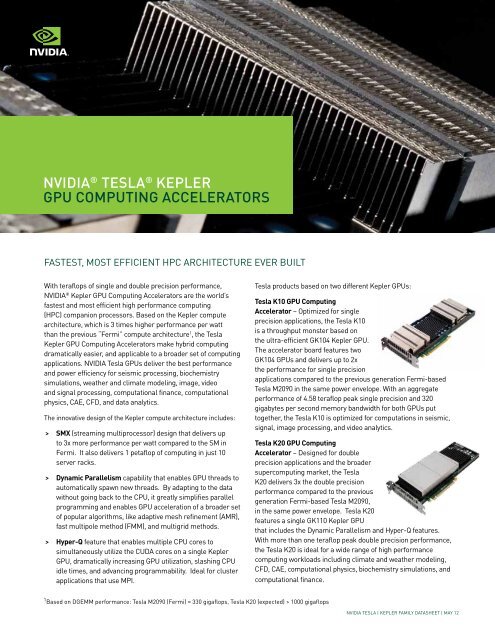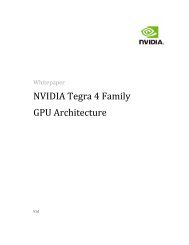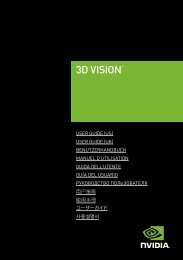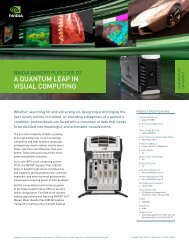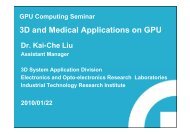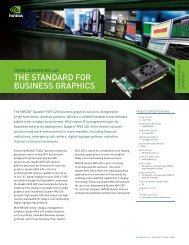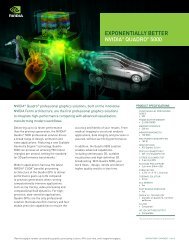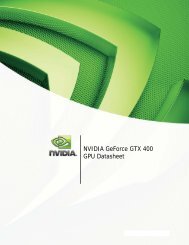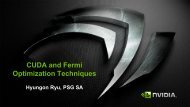Datasheet: NVIDIA Tesla Kepler Computing Accelerators
Datasheet: NVIDIA Tesla Kepler Computing Accelerators
Datasheet: NVIDIA Tesla Kepler Computing Accelerators
Create successful ePaper yourself
Turn your PDF publications into a flip-book with our unique Google optimized e-Paper software.
<strong>NVIDIA</strong> ® TESLA ® KEPLERGPU COMPUTING ACCELERATORSFastest, Most Efficient HPC Architecture Ever BuiltWith teraflops of single and double precision performance,<strong>NVIDIA</strong> ® <strong>Kepler</strong> GPU <strong>Computing</strong> <strong>Accelerators</strong> are the world’sfastest and most efficient high performance computing(HPC) companion processors. Based on the <strong>Kepler</strong> computearchitecture, which is 3 times higher performance per wattthan the previous “Fermi” compute architecture 1 , the <strong>Tesla</strong><strong>Kepler</strong> GPU <strong>Computing</strong> <strong>Accelerators</strong> make hybrid computingdramatically easier, and applicable to a broader set of computingapplications. <strong>NVIDIA</strong> <strong>Tesla</strong> GPUs deliver the best performanceand power efficiency for seismic processing, biochemistrysimulations, weather and climate modeling, image, videoand signal processing, computational finance, computationalphysics, CAE, CFD, and data analytics.The innovative design of the <strong>Kepler</strong> compute architecture includes:> > SMX (streaming multiprocessor) design that delivers upto 3x more performance per watt compared to the SM inFermi. It also delivers 1 petaflop of computing in just 10server racks.> > Dynamic Parallelism capability that enables GPU threads toautomatically spawn new threads. By adapting to the datawithout going back to the CPU, it greatly simplifies parallelprogramming and enables GPU acceleration of a broader setof popular algorithms, like adaptive mesh refinement (AMR),fast multipole method (FMM), and multigrid methods.> > Hyper-Q feature that enables multiple CPU cores tosimultaneously utilize the CUDA cores on a single <strong>Kepler</strong>GPU, dramatically increasing GPU utilization, slashing CPUidle times, and advancing programmability. Ideal for clusterapplications that use MPI.<strong>Tesla</strong> products based on two different <strong>Kepler</strong> GPUs:<strong>Tesla</strong> K10 GPU <strong>Computing</strong>Accelerator – Optimized for singleprecision applications, the <strong>Tesla</strong> K10is a throughput monster based onthe ultra-efficient GK104 <strong>Kepler</strong> GPU.The accelerator board features twoGK104 GPUs and delivers up to 2xthe performance for single precisionapplications compared to the previous generation Fermi-based<strong>Tesla</strong> M2090 in the same power envelope. With an aggregateperformance of 4.58 teraflop peak single precision and 320gigabytes per second memory bandwidth for both GPUs puttogether, the <strong>Tesla</strong> K10 is optimized for computations in seismic,signal, image processing, and video analytics.<strong>Tesla</strong> K20 GPU <strong>Computing</strong>Accelerator – Designed for doubleprecision applications and the broadersupercomputing market, the <strong>Tesla</strong>K20 delivers 3x the double precisionperformance compared to the previousgeneration Fermi-based <strong>Tesla</strong> M2090,in the same power envelope. <strong>Tesla</strong> K20features a single GK110 <strong>Kepler</strong> GPUthat includes the Dynamic Parallelism and Hyper-Q features.With more than one teraflop peak double precision performance,the <strong>Tesla</strong> K20 is ideal for a wide range of high performancecomputing workloads including climate and weather modeling,CFD, CAE, computational physics, biochemistry simulations, andcomputational finance.1 Based on DGEMM performance: <strong>Tesla</strong> M2090 (Fermi) = 330 gigaflops, <strong>Tesla</strong> K20 (expected) > 1000 gigaflops<strong>NVIDIA</strong> TESLA | KEPLER FAMILY DATASHEET | MAY 12
TECHNICAL SPECIFICATIONS<strong>Tesla</strong> K10 a<strong>Tesla</strong> K20Peak double precision floating pointperformance (board)Peak single precision floating pointperformance (board)0.19 teraflops To be announced4.58 teraflops To be announcedNumber of GPUs 2 x GK104s 1 x GK110CUDA cores 2 x 1536 To be announcedMemory size per board (GDDR5) 8 GB To be announcedMemory bandwidth for board (ECC off) b 320 GBytes/sec To be announcedGPU <strong>Computing</strong> ApplicationsSeismic, Image, Signal Processing,Video analyticsCFD, CAE, Financial computing, Computationalchemistry and Physics, Data analytics,Satellite imaging, Weather modelingArchitecture Features SMX SMX, Dynamic Parallelism, Hyper-QSystem Servers only Servers and Workstations.Available May 2012 Q4 2012a <strong>Tesla</strong> K10 specifications are shown as aggregate of two GPUs.b With ECC on, 12.5% of the GPU memory is used for ECC bits. So, for example, 6 GB total memory yields 5.25 GB of user available memory with ECC on.<strong>Tesla</strong> GPU <strong>Computing</strong> Accelerator Common FeaturesECC Memory Error ProtectionSystem Monitoring FeaturesL1 and L2 cachesAsynchronous Transfer with dual DMAenginesFlexible programming environment withbroad support of programming languagesand APIsMeets a critical requirement for computing accuracy and reliability in datacentersand supercomputing centers. External DRAM is ECC protected in <strong>Tesla</strong> K10 andboth external and internal memories are ECC protected in <strong>Tesla</strong> K20.Integrates the GPU subsystem with the host system’s monitoring and managementcapabilities such as IPMI or OEM-proprietary tools. IT staff can thus managethe GPU processors in the computing system using widely used cluster/gridmanagement solutions.Accelerates algorithms such as physics solvers, ray-tracing, and sparse matrixmultiplication where data addresses are not known beforehandTurbocharges system performance by transferring data over the PCIe bus whilethe computing cores are crunching other data.Choose OpenACC, CUDA toolkits for C, C++, or Fortran to express applicationparallelism and take advantage of the innovative <strong>Kepler</strong> architecture.Software and Drivers> > Software applications page: http://www.nvidia.com/object/vertical_solutions.html> > <strong>Tesla</strong> GPU computing accelerators aresupported for both Linux and Windows.Server modules are only supported on 64-bit OSes and workstation / desktop modulesare supported for 32-bit as well.- Drivers– <strong>NVIDIA</strong> recommends that users get drivers for <strong>Tesla</strong> server products from theirsystem OEM to ensure that driver is qualified by the OEM on their system. Latest drivers can bedownloaded from http://www.nvidia.com/drivers- Learn more about <strong>Tesla</strong> data center management tools at http://www.nvidia.com/object/softwarefor-tesla-products.html> > Software development tools are available at http://developer.nvidia.com/getting-started-parallelcomputingTo learn more about <strong>NVIDIA</strong> <strong>Tesla</strong>, go to www.nvidia.com/tesla© 2012 <strong>NVIDIA</strong> Corporation. All rights reserved. <strong>NVIDIA</strong>, the <strong>NVIDIA</strong> logo, <strong>NVIDIA</strong> <strong>Tesla</strong>, and CUDA are trademarks and/or registered trademarks of <strong>NVIDIA</strong>Corporation. All company and product names are trademarks or registered trademarks of the respective owners with which they are associated. Features, pricing,availability, and specifications are all subject to change without notice.


